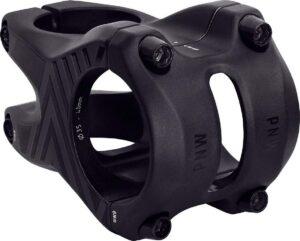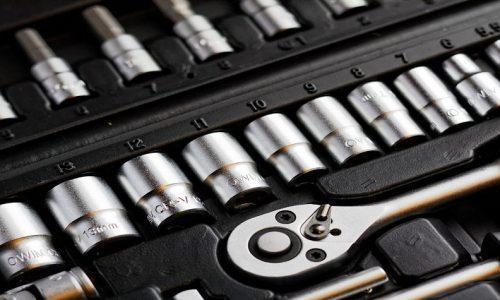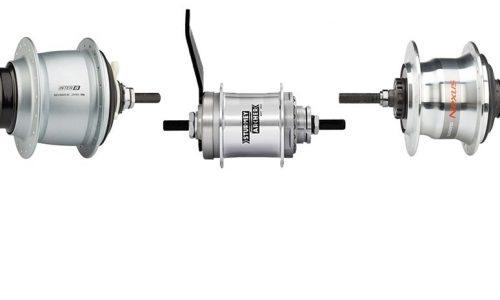Your stem is a simple component but changing it is a great way to refresh your cockpit, but the change will subtly affect how your bike performs.
In this article, we will give you all the information you need to help you choose between the best MTB stems for your mountain bike. We will also give you some examples of the best MTB stems for you to choose from.
The Basics Of MTB Stems
The stem is the component that attaches your mountain bike’s handlebars to its steerer tube. Mountain bike stems come in various shapes and lengths and have different rises, slightly altering your riding position.
They work using two bolts to clamp onto the steerer tube and four bolts to clamp a face plate to the handlebars.
Most mountain bike stems measure less than 70mm, with 40 and 50mm being the most common ones you’ll see, but you can get shorter ones.
However, before you buy a shiny new stem, you need to know if it is compatible with your mountain bike. Therefore, you must determine your steerer tube size and handlebar diameter.
Most steerer tubes have a 1-1/8th” diameter, but older ones may measure 1.5″. You can measure the top cap’s diameter to find the correct size. Next, you need to measure the diameter of your handlebars at the part where the stem clamps to it.
Most modern mountain bike handlebars either have a 31.8 or 35mm diameter. Older ones are much thinner at 25.4mm. Your new stem must have the same diameter as your handlebar for it to fit.
Mountain Bike Stem Length
Your riding position and the reach of the bike are affected by how long your stem is. Most riders who prefer shorter ones ride with 30mm stems. You can go shorter, but you’ll need to replace your handlebars with specially designed ones.
A shorter MTB stem reduces how far the handlebars extend past the steerer tube. This makes your steering more responsive and brings your weight slightly rearward, which is better for steep descents. You will see shorter stems on downhill race bikes, as the rider wants faster handling and downhill capability.
If you choose a stem too short for the bike’s top tube, you may have a cramped feeling when riding; therefore, you should go for a 50mm stem instead. You would also benefit from fitting wider handlebars to widen your reach and improve your balance.
When you first ride with a shorter stem, you may feel like the handlebars wander from side to side, especially when riding uphill. You get used to this and can overcome the weird feeling quickly.
Cross country mountain bikes are fitted with longer stems measuring 80 to 120mm. This is because the rider’s weight sits further over the front wheel, which improves power transfer to the pedals. However, their downhill capability is compromised.
Stack Height
The stack height is how much space the stem takes up on your steerer tube. You may run into problems if your steerer tube is too short for the stack height. However, changing your stem for one with a different stack height is a good way of changing your handlebar height if you need to.
Stem Rise
The rise in the stem is the difference in height between the steerer tube clamp and the handlebar clamp. Most stems don’t change your handlebar height. But you can buy stems with a 6-degree rise that can be fitted either way up to lower or raise your handlebar height by s degrees.
How The Stem Is Made
Mountain bike stems can be either forged or machined from a single aluminum billet. The forging process involves squeezing aluminum under high pressure to give the stem its shape. A forged stem is stiff but more expensive than a machined one. A machined stem is less costly and has a better finish thanks to precision CNC machining.
Our Recommendations For The Best MTB Stems
Race Face Turbine R 35 Bike Stem
The Race Face Turbine R35 bike stem is machined from 7075 alloy, which is super strong but also lightweight. As soon as you take it out of the box, you can see that it is a quality component and one of the best MTB stems.
This mountain bike stem suits chunky handlebars with a 35mm diameter. It works perfectly with Race Face’s Next R 35 handlebars, which is worth thinking about if you want to upgrade your cockpit further.
You can buy this stem in 40, 50, 60, and 70mm lengths. It is a flat stem with no rise and has a stack height of 42mm.
The Race Face Turbine R35 uses the company’s ‘Overbite’ faceplate and ‘Top-Lock’ clamp. This is designed to distribute the clamp’s pressure evenly, but it also makes it super easy to fit.
If you’re looking for a tough stem for trail and enduro riding, the Race Face Turbine R35 is a good choice. It even comes in nine colors, so you should find one that suits your bike’s color scheme.
PNW Components Range Gen 3 Stem
The PNW Components Range Gen 3 stem is chunky, but it has some features that make it more functional than the average MTB stem.
It is machined from 6061 aluminum and is 40g lighter than its gen 2 predecessor (depending on what length and diameter you go for). You can choose between 40 or 50-mm versions with 31.8mm or 35mm clamp diameters.
This stem is well made, and its subtle color and aesthetics should go with most frame colors. PNW has added a range of markings to the Range to make it super easy to dial in your perfect cockpit. It even has the recommended torque settings, and installation is effortless.
A handy feature on the face plate is the window so you can perfectly align your handlebar in the center. But this window also allows you to set up the included GoPro mount to look down the trail from the center of your handlebars. You can use the mount to place a light or anything else that uses a similar interface.
Although this stem is a little heavy and there isn’t an option for a short version, the PNW Range Gen 3 is a nicely made stem with some good features and a great look.
Industry Nine A318 Stem

The A318 stem from industry Nine is a lightweight stem made from high-quality 7075 aluminum. It follows the popularity and sucesss of the A35 and expands the company’s al-mountain range of stems.
You can buy 30, 40, and 50mm long versions in a combination of eleven colors to suit your preferences. The wide choice of anodized colors has never been seen on a mountain bike stem before, so you can perfectly match your bike with a bit of thought.
It fits handlebars with a 31.8 diameter, so if you’re looking to change the length of your stem while adding a bit of bling to your bike, the Industry Nine A318 Stem is a great choice.
Hope AM/Freeride Stem

Hope makes some fantastic mountain bike components, and this All-mountain/Freeride stem is no exception. If you appreciate precision machining, you’ll love how this stem looks. On close inspection, you can see how the machining center has done its work with its cool cutting tool patterns.
You can buy this stem in several lengths, and each option has a zero-rise. But the more extended options have a 20-degree angle, so you can finely tune your handlebar height.
As you’d expect from Hope, you get fancy stainless steel bolts that are not only super strong but resistant to rust for longevity. The faceplate is neat and tidy, thanks to the zero-gap design. It also means that you can’t install it off-center.
You can choose from a selection of cool colors that compliment the flawless finish of the component.
Paul Components Boxcar Stem

The Boxcar Stem from Paul Components is made from 2024 aircraft aluminum to give it the optimum amount of stiffness, weight, and strength. This is complemented by the boxy shape, making it 25% stiffer than most other stems.
It comes in lengths of 50, 70, and 90mm and is available in four colors. You can choose between 0 and 15-degree angles of rise too.
This stem is suitable for a 28.6mm steerer tube and a 35mm handlebar. You’ll love how Paul Components Boxcar looks and performs, but it is super easy to fit onto your bike too. It uses T25 Torx screws that distribute the force better than traditional Allen bolts. They also encourage you to use a torque wrench, preventing overtightening of the faceplate.
Final Thoughts
Changing your bike’s stem is a good place to start if you want to tweak your riding position. Remember, short stems improve steering and handling characteristics and are better for general riding. In comparison, longer stems help with power transfer but compromise how stable your bike feels on downhill sections due to your weight being brought forwards.
Our examples of the best MTB stems above will give your mountain bike that “handlebar jewellery” it’s been crying out for, while allowing you to fine-tune your riding position.

Tom Fortune has been reviewing cycling products for several years from his home in the French Alps. As the owner of mtb-threads.com, he mainly reviews mountain bike products but also reviews road cycling products independently.




